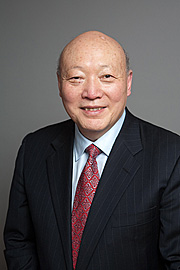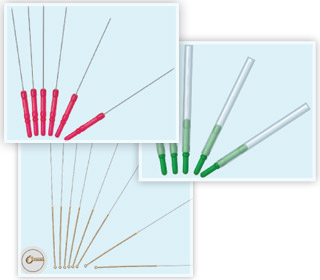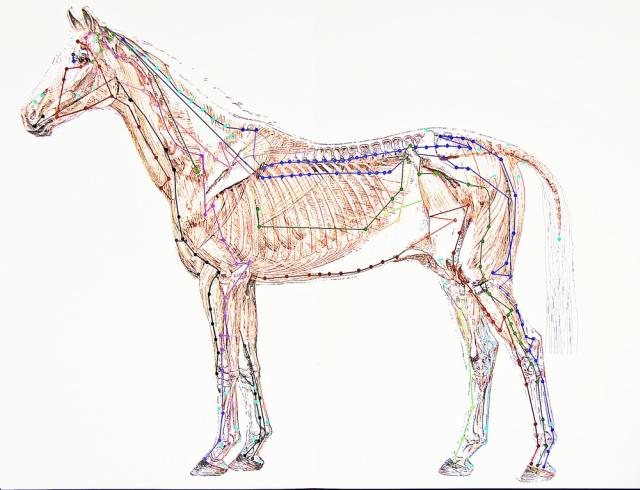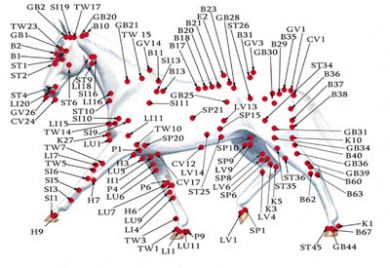| Home Medical Index | First Posted: Dec 22, 2010 Jan 21, 2020 | |
Acupuncture/Humans and HorsesI was stationary in my automobile, behind a stopped school bus, when a teenager hit me from behind in 1985. She was traveling at around 45 miles an hour when she hit the back of my car and pushed my vehicle into the back of the bus. The impact was severe and left me with life time spinal problems--pain and headaches that have been with me since that collision. After many years of doctors, medications, physical therapy, MRI's, CAT scans, etc., there was very little relief. Recently, out of desperation, I contacted my neurosurgeon whom I admire and trust. He suggested that I try acupuncture as it has a good tack record for pain management. He referred me to Xiao Ming Tian. It just so happens that "Ming" as Xiao Ming Tian likes to be called, served in the Clinton Administration on the White House Commission on Complementary and Alternative Medicine Policy I had read about acupuncture and knew that it is used on horses, with much success, for a myriad of problems. If it is good enough for my horse, it is good enough for me! Xiao Ming Tian, Ac, CMD, in Bethesda, Maryland is like a miracle worker! I have been going to him for two weeks and my pain is being controlled. I have not felt this good physically or psychologically since that accident all those years ago. It is quite amazing how constant pain takes its toll!  "Ming" aka Xiao Ming Tian, Ac, CMD, in Bethesda, Maryland Academy of Acupuncture and Chinese Medicine My miracle worker! About Acupuncture
I wanted to try to have some understanding about what acupuncture is and does. It is not as easy as that. Unlike Western medicine which seems to treat symptoms--as I tell my husband "patch, patch--patch, patch," Eastern medicine, in this case--acupuncture--treats the whole body. It appears to be a system that is complete and even more--it is basically non-invasive other than a few needles. These needles are strategically placed, after a thorough consultation and provided medical history, in acupoints in the body. Acupuncture is one of the oldest and most commonly used forms of traditional medicine in the world--dating back for at least 2,500 years. The general theory of acupuncture is based on the premise that there are patterns of energy flow called Qi (pronounced "chee") throughout the body that are essential for optimal health. You might be interested to know that the National Institute of Health (NIH), reported that "studies have demonstrated that acupuncture can cause multiple biological responses, mediated mainly by sensory neurons, to many structures within the central nervous system. This can lead to activation of pathways, affecting various physiological systems in the brain, as well as in the periphery." NIH went on to state that acupuncture "may activate the hypothalamus and the pituitary gland, resulting in a broad spectrum of systemic effects. Alteration in the secretion of neurotransmitters and neurohormones, and changes in the regulation of blood flow, both centrally and peripherally, have been documented. There is also evidence of alteration in immune functions produced by acupuncture." 1997 National Institute of Health Consensus on Acupuncture You will read about and hear the term "Qi" "chi" or "ch'i." It means vital energy. The following is some information about Qi:
Pulses are extremely important to the acupuncturist. Many problems will be detected in the pulses. You notice that there is an "s" on pulse. More on "pulses" below:
Your Tongue

Needles
 The word "needle" is often synonymous with tenseness and fear! People seem to have an aversion to needles. It is important to note that all needles are not the same! I have not had any discomfort when the needles were inserted. They are really small--ask your acupuncturist to see some. I would say they have the circumference of a human hair--really small around. The needles typically are inserted from 1/8" to 1 1/2". On occasion I noticed a bit of tingling or the feeling of a tiny electrical charge. It almost felt like energy moving in my body where the needle was inserted. It produced a pleasant feeling of warmth and tingling. I have also felt a throb when one was put in my lower leg. My leg reacted involuntarily much like when a Western doctor tests your reflexes in your knees or elbows. Apparently these reactions are called the "Qi" sensation and is considered a good sign. There was just a moment of discomfort--tiny! I can tell you that the pain relief that I have had far outweighs any momentary discomfort. 5 Western Medicine Theories on Why Acupuncture Works
The following are five prevailing theories posted by the western medical community, using scientific terminology, to explain acupuncture's effectiveness. These are based upon studies performed before and after acupuncture, using blood draws to measure biomedical changes in the body. The Gate Control Theory: Pain signals must pass through a number of high traffic gates as they move from the area of injury upward through the spinal cord into the brain. Like a road or a highway, these nerves can only handle a limited number of nerve signals at one time. Acupuncture generates competing stimulus and effectively interrupts the neurotransmitters of the pain signals from reaching the brain. This results in the patient never getting the pain signal and, therefore, never getting the pain. This is the most popular theory among Western scientists. The Augmentation Theory: Acupuncture affects the concentrations of triglycerides, cholesterol, and phospholipids which suggests that acupuncture can both raise and diminish peripheral blood components. Also, specific hormones, prostaglandins, white blood cells (WBC's), gamma globulins, opsonins The Endorphin Theory: Acupuncture stimulates the secretion of endorphins (Endorphins) The Neurotransmitter Theory: This states that certain neurotransmitter levels (such as Seratonin The Circulatory Theory: There is an effect of constricting or dilating of blood vessels, from doing acupuncture. A possible explanation of this is the release of the body's vasodilators such as Histamine, Acupuncture manipulates the electrical system of the body. It creates or enhances closed-circuit transport of energy in the tissues. The outcome is healing. The following are a few of the maladies that can be treated with acupuncture: Addiction (alcohol, drugs, smoking, food), anxiety, arthritis, asthma, bronchitis, carpal tunnel syndrome, chronic fatigue, colitis, the common cold, constipation, dental pain, depression, diarrhea, digestive trouble, dizziness, dysentery, emotional problems, some eye problems, facial palsy and tics, fatigue, fertility, fibromyalgia, gingivitis, headache, hiccough, incontinence, indigestion, irritable bowel syndrome, lower back pain, menopause, menstrual cramps and irregularities, migraine, morning sickness, nausea, osteoarthritis, pain, PMS, pneumonia, reproductive problems, rhinitis, sciatica, seasonal affective disorder (SAD), shoulder pain, sinusitis, sleep disturbances, sore throat, stress, tennis elbow, tonsillitis, trigeminal neuralgia, urinary tract infections, vomiting, wrist pain to name a few. This is only a little snippet about the vast knowledge of acupuncture. I have researched this for my own edification and wanted to share it on HorseHints.org. I wanted to have some understanding of the treatment that I am receiving. I can only tell you, thus far, that I am a proponent of acupuncture. If the results that have been achieved are sustainable, I will be a person who is beyond overjoyed!!!! A big thank you to my neurosurgeo of many years, Jeff Jacobson, for not being quick with the scalpel--that is not wanting to operate at this time--and referring me to Dr. Ming for pain management. I could not be happier! I can only think of one caution when going to any medical practitioner--get a referral from a doctor that you trust. Mine was my neurosurgeon. It does not get better than that for spine or brain. If a friend or acquaintance gives a referrel to you, like anything, make sure to check out the doctor's credentials. Do your research first. But oh, isn't it that way with anything? For More Information:
Acupuncture for Horses Acupuncture Meridians of the Horse Note: Treating Laminitis with Acupuncture  Full Circle Equine Service/Dr. Jana Froeling There are four major types of points, motor points, type 1-dorsal and ventral midline, type 3-superficial nerves and nerve plexus, and type 4-muscle tendon junctions. Stimulating methods include dry needling, aquapuncture, hemopuncture, moxabustion, electrical and laser. Therapeutic effects include pain relief, immune system altering, fever reduction, anti-inflammatory, stress relief, behavioral modification, and performance enhancement. There are 14 major meridians that are interconnected and follow the superficial nerve pathways and are located by anatomical landmarks. The meridians carry energy and nutrients to the entire body, help in immune defense, link all tissues and organs, and can transmit pathogens and acupuncture energy. The acupuncturist uses numerous theories to decide which points to stimulate. The two major theories are yin-yang and 5 element. The tenets of yin-yang theory are that everything in the universe has two opposite aspects. Yin and yang control each other, mutually create each other and can transform into each other in certain circumstances. The theory is used to qualify the symptoms, describe the disease process and determine treatment. Five element theory is based on the interconnected elements of fire, earth, metal, water, and wood. Other theories include tongue and pulse diagnosis, jing well points, and zang fu patterns. Acupuncture is used often for muscular skeletal injuries including sprains, strains, laminitis, and navicular disease. It can also be very effective for immune system diseases such as allergic respiratory disease, uveitis, equine protozoal myelitis and lyme disease. It can also help with reproductive and behavior problems. Acupuncture is one part of Traditional Chinese Veterinary Medicine. It is a very detailed, expansive medical art that offers an adjunct to Western medicine to speed recovery and an alternative when Western medicine fails. Chiropractic and acupuncture are established medical arts that can contribute to speeding recovery from illness and injury and maintaining optimal health and performance. erinary acupuncture is the practice of performing acupuncture on animals.Definition and History Acupuncture may be defined as the insertion of needles into specific points on the body to cause a desired healing effect. This technique has been used in veterinary practice in China, in a very limited form, to treat certain ailments. The Chinese also use acupuncture as preventive medicine against such problems as founder and colic in horses. The major emergence of Veterinary Acupuncture onto the medical scene did not actually take place until the early 1970s. Oddly enough, this did not occur in China, but in the United States. Veterinary Acupuncture was introduced into the United States in 1971, by members of the National Acupuncture Associations research team: Dr. Gene Bruno and Dr. John Ottaviano. In the process of treating thousands of small animals and several hundred horses, Bruno and Ottaviano trained Veterinarians who later founded the International Veterinary Acupuncture Society (IVAS). Veterinary Acupuncture is used all over the world, either by itself or in conjunction with Western medicine, to treat a wide variety of maladies in every species of domestic and exotic animals. Modern veterinary acupuncturists use solid needles, hypodermic needles, bleeding needles, electricity, heat, massage and low power lasers to stimulate acupuncture points. Acupuncture is not a cure-all, but can work very well when it is indicated. Acupuncture is indicated mainly for functional problems such as those that involve paralysis, noninfectious inflammation (such as allergies), and pain. For small animals, the following are some of the general conditions that are treated with acupuncture:
For large animals, acupuncture is again commonly used for functional problems. Some of the general conditions where it might be applied are the following:
In addition, regular acupuncture treatment can treat minor sports injuries as they occur and help to keep muscles and tendons resistant to injury. World-class professional and amateur athletes often use acupuncture as a routine part of their training. Acupuncture is used on many animals involved athletic endeavors, such as racing, jumping, or showing. Treatment and SafetyFor small animals, the insertion of acupuncture needles is virtually painless. The larger needles necessary for large animals may cause some pain as the needle passes through the skin. In all animals, once the needles are in place, there should be no pain. Most animals become very relaxed and may even become sleepy. Nevertheless, acupuncture treatment may cause some sensation, presumed to be those such as tingles, cramps, or numbness which can occur in humans and which may be uncomfortable to some animals. Acupuncture is one of the safest forms of medical treatment for animals when it is administered by a properly trained veterinarian. Side effects of acupuncture are rare, but they do exist. An animal's condition may seem worse for up to 48 hours after a treatment. Other animals may become sleepy or lethargic for 24 hours after acupuncture. These effects are an indication that some physiological changes are developing, and they are most often followed by an improvement in the anima's condition.The length and frequency of acupuncture treatments depends on the condition of the patient and the method of stimulation that is used by the veterinary acupuncturist. Stimulation of an individual acupuncture point may take as little as 10 seconds or as much as 30 minutes. A simple acute problem, such as a sprain, may require only one treatment, whereas more severe or chronic ailments may need several or several dozen treatments. When multiple treatments are necessary, they usually begin intensively and are tapered to maximum efficiency. Patients often start with 1-3 treatments per week for 4–6 weeks. A positive response is usually seen after the first to third treatments. Once a maximum positive response is achieved (usually after 4-8 treatments), treatments are tapered off so that the greatest amount of symptom free time elapses between them. Many animals with chronic conditions can taper off to 2-4 treatments per year. Animals undergoing athletic training can benefit from acupuncture as often as twice a week to once a month. The frequency depends on the intensity of the training and the condition of the athlete. There are two important criteria you should look for in a veterinary acupuncturist: 1. Your veterinary acupuncturist must be a licensed veterinarian. 2. Your veterinary acupuncturist should have formal training in the practice of acupuncture for animals. (For example, the International Veterinary Acupuncture Society offers an accredited certification program for veterinary acupuncturists.) In most countries, states, and provinces, veterinary acupuncture is considered a surgical procedure that only licensed veterinarians may legally administer to animals. For More Information: Acupuncturing Away the LazyEquine Acupuncture-Is It for Your Horse? Equine Acupuncture The American Academy of Veterinary Acupuncture International Veterinary Acupuncture Society EPM and other Reactive Points on Equine/Video |